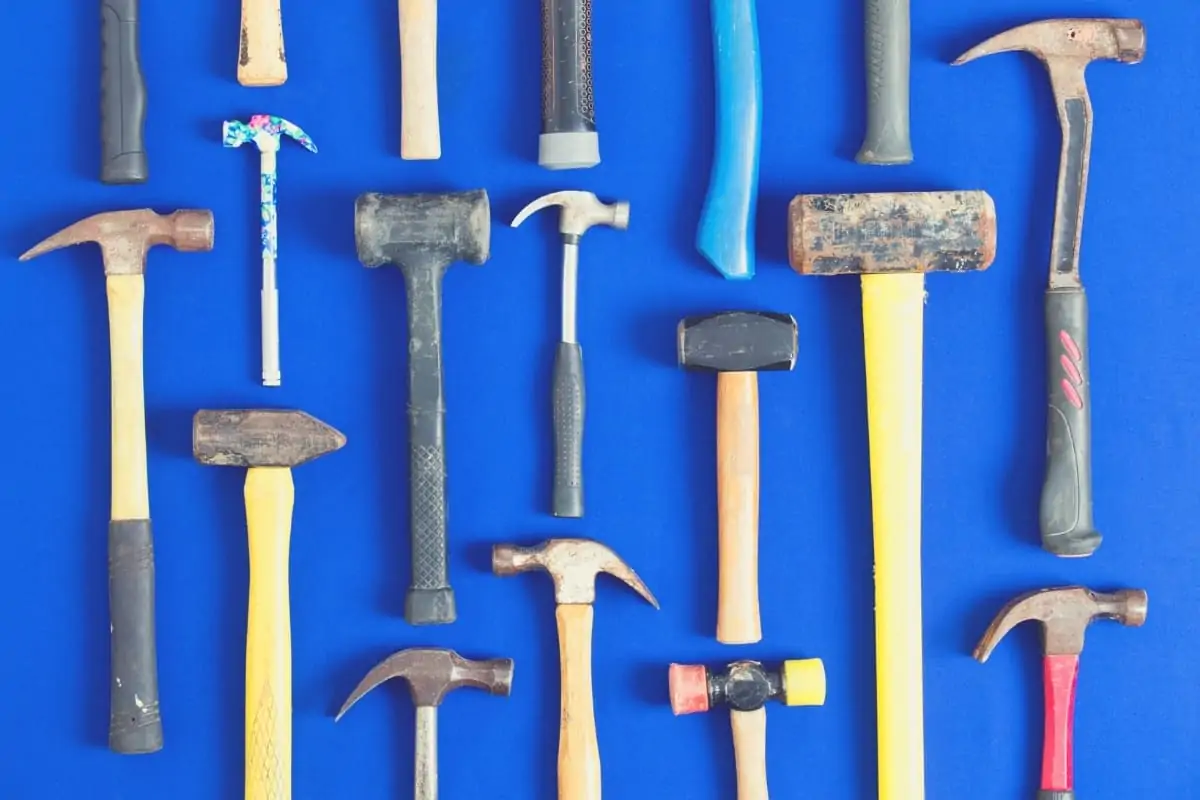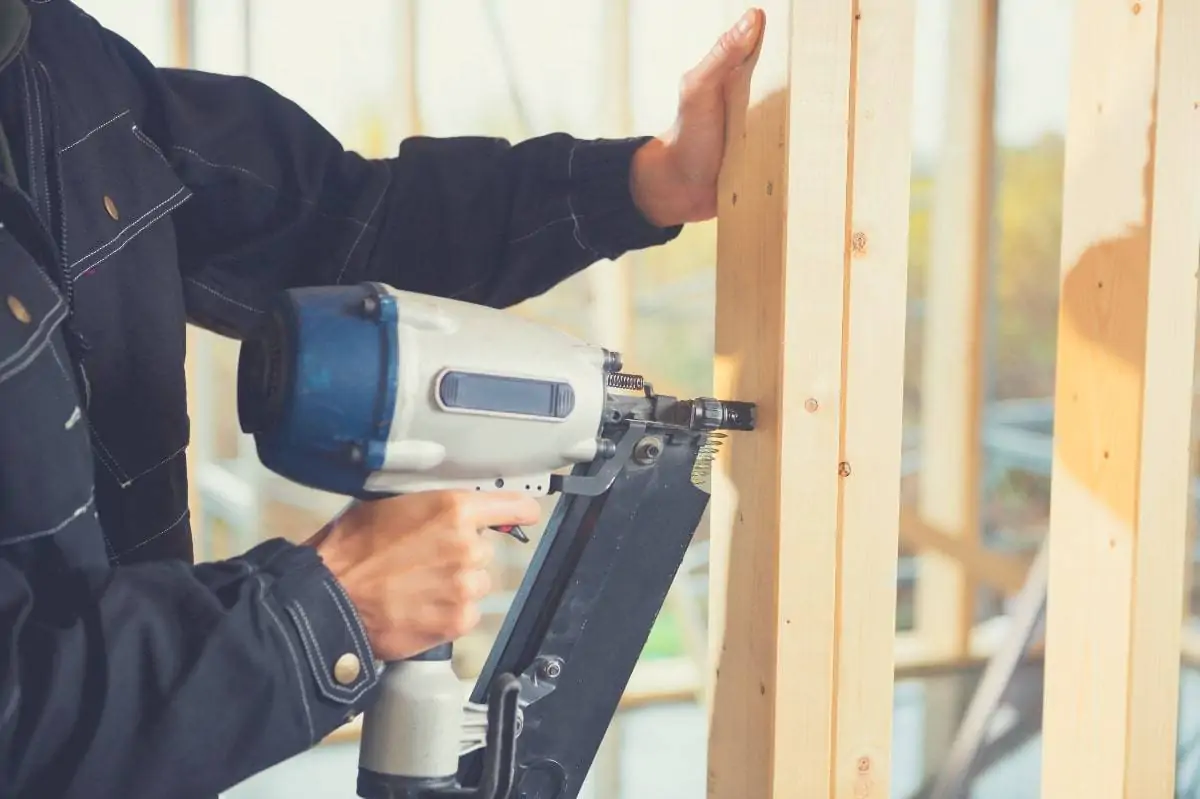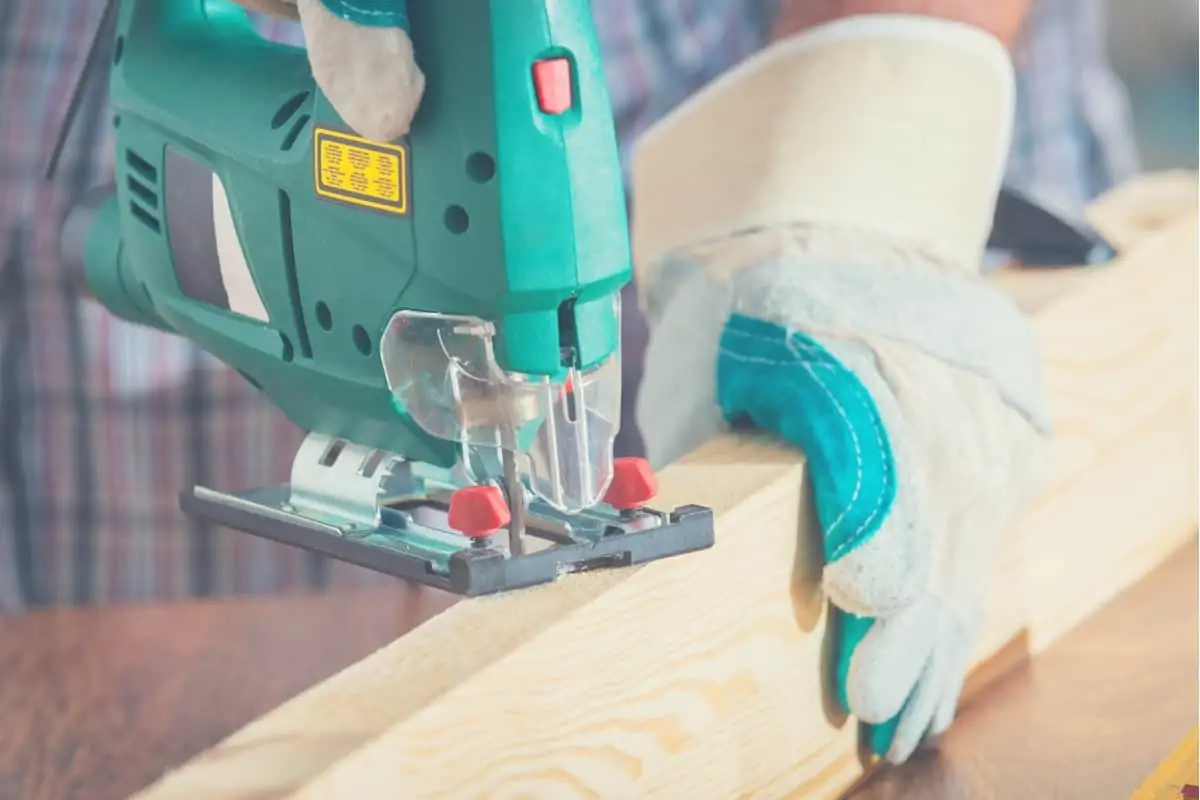Hammers are possibly one of the oldest tools available. For thousands of years, they have been a tool primarily used to hit things with, but modern-day hammers can do so much more.
Their general design has evolved over the years, making it an extremely versatile tool to have in your toolbox. However, more specific changes have made certain types of hammers very specialized.
There are three essential components: the head, which you use to hit things with; the handle that provides various levels of swing or increased precision: and the back part of the hammer head that might include a hook, peen, or claw.
To save you some time and help you find the right hammer for the job, I’ve compiled the following list. I’m going to explain what each one is, what you might use it for, and introduce any defining characteristics.
Common Types of Hammer
The range of hammers available is vast. That being said, for the average person, two or three in your tool bag should be more than adequate.
The most common types of hammer, for the professional and DIYer, are as follows:
Ball Peen Hammer
A ball-peen or ball pein hammer is often referred to as a mechanics’ hammer or engineers’ hammer because these are the professions that commonly use them.
There are two heads: one head is ball-shaped and round for shaping metal. This process is known as peening. The second head is flat, and you use it for striking chisels and punches.
You can also use a ball peen hammer for smoothing edges on metal pins or fasteners and closing over rivet openings.
Ball peen hammers can weigh anything from 4oz up to a couple of pounds. However, the more common sizes are between 8 and 12oz. The handle is typically hickory or ash wood.
More modern versions of this tool tend to have a handle made of a material that absorbs vibrations, making it more comfortable to use for long periods.
Claw Hammer
Claw hammers are possibly the most common type of hammer and a very versatile one to have in your toolbox. It’s also one of the most recognizable hammers because of its forked, curved claw.
Essentially, they are for removing nails from wood. Acting similarly to a fulcrum, they lever the nail out of the wood.
Watch this video for a clear explanation of how a fulcrum or a lever works:
This type of hammer works well if you’re dismantling plaster, floorboards, small woodcuts, and timber.
Club Hammer
This hammer is also called a lump or a drilling hammer and looks similar to a sledgehammer. However, the two faces and the handle are much smaller.
It’s popularly used for light demolition jobs and driving masonry heads and steel chisels.
On average, this type of hammer weighs around three pounds, although some are much heavier. The handles can be wooden or made from a material that is good at absorbing vibrations.
Dead Blow Hammer
This is a specialized type of mallet used because its design minimizes damage to the surface you’re striking. You’re able to better control the striking force, and the rebound is minimal.
You use a dead blow hammer for a range of applications, for example, popping out minor dents, knocking pieces of wood together, dislodging parts, and freeing hydraulic cylinders.
The head of a dead blow hammer can be hollow or solid. Hollow heads are often partially filled using steel shot. Solid-headed versions are mostly made using resilient plastic or rubber.
Framing Hammer
A framing hammer is very similar in appearance to a claw hammer but tends to be heavier and longer. The main difference is that it will have a waffled head and a straight claw.
It is mainly used for framing, hence the name. You’ll find it’s most popular for the construction of timber frame houses.
The waffle or checkered face is its most defining feature. This finish on the hammer head reduces the amount of slippage when you strike the nails. It also leaves a mark on the wood, but this is no longer visible once the frame is complete.
Rubber Mallet
This is one of the most common types of mallet. It has a rubber head that delivers softer blows. You can use it on sheet metal, upholstery, and for various woodworking applications. It’s also gentle enough if you want to use it to ease plasterboard in place and not damage it.
Sledge Hammer
A sledgehammer is similar to a club hammer but much larger. The handle is longer, and it weighs much more, often as much as 15 pounds. If you want to use a sledgehammer, you have to swing it like an ax.
You would commonly use a sledgehammer for demolition work, but they can also be handy if you need to drive in stakes, such as erecting fencing.
Most sledgehammers have a wooden handle, although you will also find them made using fiberglass, which is a very ergonomic material.
Tack Hammer
Also called an upholstery hammer, a tack hammer is a lightweight tool that you would use to drive tacks into furniture and other surfaces. They used to be very common, but nowadays, people replace them with automated hammers or staple guns.
A tack hammer has two heads, one of which is magnetized and the other slotted. You would use the magnetized head to start off and then change it around and use the normal head to finish driving the tack in.
Specialized Types of Hammer
Next, we’ll look at types of hammers that you’re not going to encounter very often. You use them for specific tasks. Some look very similar to more common hammers, apart from their weight, size, or shape.
Blacksmith Hammer
Blacksmiths require a durable and robust tool when they want to shift and move metal, so they use a blacksmith hammer. It’s similar to a sledgehammer but has a head that is forged from high carbon steel.
There are various styles to choose from, depending on what you plan to use it for. You can use them for heavy cold and hot forging work and work that is more detailed.
Blocking Hammer
A blocking hammer is another tool that blacksmiths often use. On one side, it features a square head, while on the other, it has a cylindrical or hemispherical head. The heads can be plastic, metal, or wood.
Most commonly, it’s a hammer you would use to shape metal either on an anvil or a block. However, it’s also a hammer used in a metal shop when working on steel or aluminum-based projects.
Brass Hammer
Brass hammers are another type of sledgehammer, but in this case, they have a solid brass head that’s cylindrical in shape.
You would use one if you wanted to pound metal but didn’t want to damage or mark the surface.
Brass is a metal that is nonferrous and doesn’t create a spark when it strikes, which makes it very safe to use if you’re working close to combustible materials.
Watch this video to find out how to determine a metal by its spark:
Brick Hammer
This hammer is more of a chipping tool than a full-on hammer. One head is narrow, one of its uses is to split bricks, while the other is more of a claw shape. You can use this head for scoring bricks and masonry, much like you would use a chisel.
Professional masons always have one of these close to hand, but you’ll also find it useful in the home for a hardscaping project you might be doing in your backyard.
A brick hammer’s handle is designed to absorb any impact when used to strike bricks and stones.
Bushing Hammer
This very unusual-looking hammer looks similar to something you might use to tenderize meat in your kitchen. They come in a variety of shapes and sizes, can be handheld or electrical.
A tool like this is mainly for masonry work if, for example, you wanted to add texture to your hardscaping project. You would use it to make the stone’s surface rougher and look more aesthetically pleasing or make a stone pathway less slippery.
Cross Peen Hammer
Cross peen or cross pein hammers come in various sizes, but they all share the same shaped head. What you use them for depends on the strength and weight of the head. Heavier versions mainly shape metal, while smaller versions are better for driving small tacks or nails into wood.
One side of the head is shaped like a wedge, while the other is cylindrical. Blacksmiths use this tool for riveting and forging.
Cross Peen Pin Hammer
This is a much lighter version of a cross peen hammer, and more often than not, you would use it when you want to nail small nails in wood. The wedge is what you would use to set the nail, and then you turn the hammer around and use the flat head to finish it, setting the nail completely.
Chasing Hammer
Chasing hammers have a rounded head that is polished and made of steel. This head is primarily used for peening and flattening metal. It also has a much smaller ball-peen than a standard ball-peen hammer that you would use if you wanted to rivet.
A hammer like this is ideal if you work with metal, but particularly useful when making jewelry.
The handle is an unusual shape in that it is thin near the hammer end but has a bulbous end. This design improves balance when you use it.
Drywall Hammer
This type of hammer is also known as a plasterboard hammer. It is lightweight, straight, and shaped like other types of peen hammers. One side of the head is serrated, while the other is shaped like a small hatchet but with a small notch on the bottom of the blade.
You’ll find this hammer very handy if you’re hanging drywall. You will use the hatchet’s notch to hold nails in place and don’t want to damage the drywall paper. The hatchet blade you would use to remove excess drywall without damaging it.
The rounded and serrated face is better for hanging drywall than a traditional square-faced hammer because it won’t dent or damage the surface of the drywall.
Electrician’s Hammer
An electrician’s hammer is shaped like a claw hammer, but the neck of the head is extended. It allows the user to strike nails that are in difficult-to-reach locations.
Another difference is that the construction includes rubber-coated grips and insulated fiberglass handles. These provide protection as electricians often use them when working on electrical installations.
Engineering Hammer
Traditionally, railroad engineers would have used this type of hammer. The head is rounded on one end and has a wedge peen on the other.
The hammer weighs less than one kilo and has a handle that ranges from 30 to 35 centimeters.
Hatchet Hammer
Often called a half-hatchet or rigging ax, this unusual hammer has a blade that looks more like an ax rather than a peen.
You can use this hammer for a range of tasks, whether you’re at home, on a worksite, or the farm.
The head is usually made from steel and carbon alloy. Its weight will be no more than 22oz, and it will typically have a hickory handle that is 18 inches in length.
Joiner’s Mallet
This type of hammer consists of a wooden block that rests on a handle. You would use it for many carpentry tasks, including tapping joints into place, placing dowels, and other tasks you can’t use a metal hammer for because they cause too much damage.
The head of this mallet is tapered because this ensures proper contact. The wood for the handle will be hardwood, for example, beech.
Lineman’s Hammer
A lineman’s hammer can vary in design. Some look very similar to a mini-sledge hammer, while others resemble club hammers.
People commonly use them for hammering heavy-gauge lags and staples into utility poles that are pressure treated. This tool is solid steel with a polished finish. It will include a grip that absorbs shocks.
Auto Mechanic’s Hammer
You’ll also hear an auto mechanic’s hammer called a body mechanic’s hammer. It’s become known as this because you would use it with a dolly for removing dents in the panels of cars.
The hammer has a long pein with a tip that is a conical-shaped die and a flat head.
Piton Hammer
This is one type of hammer you’re probably not going to need in your toolbox, as climbers mainly use it when rock climbing. Other names for this tool include an aid hammer, big walls, walls, and a rock-climbing hammer.
Climbers use the tool to place pitons into the rock face. This hammer also has a straight pen that they use to remove pitons.
There are a couple of types. One looks like an anvil and is quite heavy, while the other is much lighter and has a hollow handle. Each has a specific rock climbing application.
The heavier version of the tool drives pitons into the rock face much more effortlessly and causes less fatigue. However, a climber would use the lighter model if they wanted to use fewer pitons and were concerned about their weight load.
Planishing Hammer
This is a hammer people use in metalworking applications. You can use it to smooth out metal that still has hammer marks on it. Its name relates to the planishing process, a term that covers the restoring welds or metal to their original, smooth appearance.
The hammer has a pein with a cylindrical die at its tip and a convex head on the other side.
Rip Hammer
A rip hammer is often called a smooth face hammer. It has many similarities with a claw hammer, but there is one significant difference. The claw of a rip hammer is straight rather than curved. This allows the hammer to extract nails that are in hard-to-reach or tight locations.
You can use this hammer for a range of different tasks. Possible applications include framing, demolition, woodworking, and finish carpentry.
Hammers of this kind can have a variety of neck and handle materials and be made from different types of steel. It’s also possible for the hammer to have some extra features. There might be a lanyard hole in the handle for ease of portability, a magnet on its cheek, or a nail starter on the tools bell.
Rock Hammer
A rock hammer is also called a pick hammer. It’s a small tool with a pick or a chisel on the back and a flat head.
You can use the chisel end for removing vegetation, making small holes, or splitting softer rock. Most commonly, people use it in historical excavations and geology for breaking up small rocks.
It’s popular with geologists because of its ability to cleanly split hard stones. You may find a bricklayer with this tool as it works very well for breaking up old joints in brickwork.
Scaling Hammer
There are two types of scaling hammer: regular and heavy-duty. People use this tool to effectively remove corrosion, coats, and other kinds of accumulation from almost any surface. The heavy-duty version comes into its own for breaking down thicker materials.
Other tasks this tool can perform include caulking, scrape-cleaning, removing rust and paint, chipping, casting, and billeting.
This tool features a pick and vertical chisel rather than more normal heads.
Shingle Hammer
Roofers commonly use a shingle hammer. It features a spike, a square head, and sometimes a claw on the head’s side. They use the claw part for removing nails and the other parts of this hammer for cutting, snipping, and tripping all types of roofing shingles.
The head is solid steel, while the handle is generally nylon vinyl. This means the tool is easier to grip and more comfortable to use.
Soft-Faced Hammer
Also known as a lathe hammer, this type of hammer can be either soft or firm rubber. There may also be the option of plastic or copper for the face. Some versions of this hammer are adjustable and include exchangeable faces.
You would use this hammer for striking material that is more delicate. A good example is chrome. Other common applications include the installation of interior doors and cabinet setups.
Spike Maul Hammer
Railroad engineers and maintenance specialists use this tool for driving spikes into opposite sides of the rails in order to protect the handle. They have 30 to 36” handles and weigh between eight and twelve pounds.
At the end of the handle, a twin-faced head is elongated and made from hardened steel. To help deliver the correct strike and drive the spike deep enough, the heads are 12” long.
Another version of this tool has a longer and thinner side, allowing the user to drive spikes over high rails or near planks. There’s also a model that has cylindrical heads.
Stone Sledge Hammer
This is a sledge hammer designed for stonemasons. It is very efficient when it comes to breaking up concrete and stone. Unlike a standard sledge hammer, this tool has one striking face, which is oval and a short straight peen. The function of this part of the tool is napping or making score lines in stone.
Straight Peen Hammer
A straight peen hammer is almost the same as a cross peen hammer. However, in this case, the peen is vertical. You can use it for starting nails, but it is much better suited for metal shaping.
Tinner’s Hammer
The design of a tinner’s hammer means you can use it to create seams and rolled edges in soft, thin metal, such as tin.
It has a square head that prevents any damage to the metal and a cross peen you use to peen down rivets.
Toolmaker’s Hammer
This is one of the more bizarre-looking hammers on my list. It has a rounded and a ball pein head, but in the center, you’ll find a magnifying glass mounted in rubber that is shock resistant. You use the magnifying glass to see your strike and punch zone and keep your eyes on the workpiece simultaneously.
This tool is usually used for more delicate jobs in a machine shop.
It weighs just 4oz and is made chiefly from forged steel that has a chromium finish.
Trim Hammer
This is a smaller cousin of the claw hammer that you would use to drive trim nails. Also known as a finish hammer, it has a smooth face that doesn’t damage the surrounding area. It is equally precise when it comes to pulling nails.
The tool’s length is usually a little over 14,” and it can weigh almost 17oz. The handle is similar in style to an ax, is very durable and comfortable to use.
Welding Hammer
Also known as a chipping hammer, there is a vertical pein on one end and a round chisel on the other.
You use this type of hammer to remove slag from welds once the bead has cooled.
The design of the handle is what makes it stand out because it looks like a spring rather than a handle. The spiral handle dissipates heat efficiently.
Upholstery Hammer
This type of specialty hammer is also referred to as a tack hammer. It’s a small tool you can use when making upholstered furniture. The hammer’s face is magnetized, which helps with the placement of the nails and tacks you use to secure the upholstery to the furniture frame.
Final Words
Hammers can be a worthwhile investment, but with so many to choose from, it’s critical you purchase the right one for your needs. Now you know a little more about your options, you can better appreciate what to look for.
If you’ve found this list useful, I’d love to hear from you. Likewise, if you’d like me to add something to the list, please leave a comment below.









































